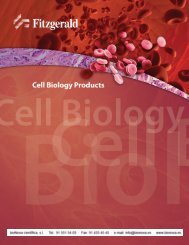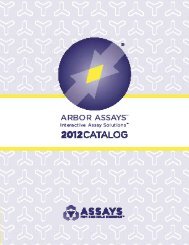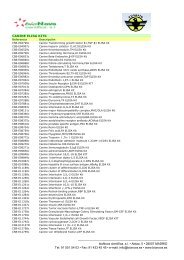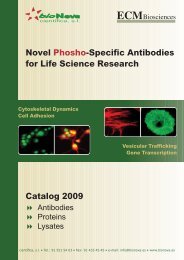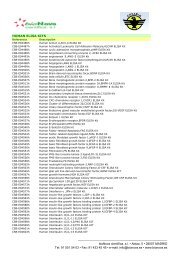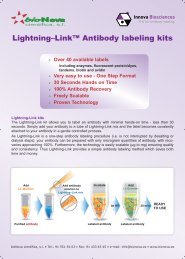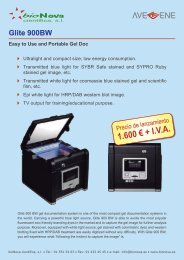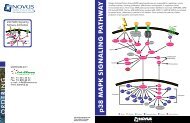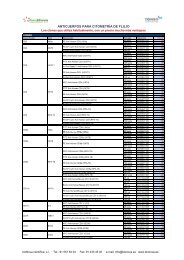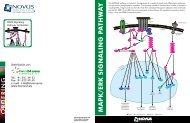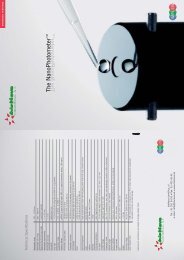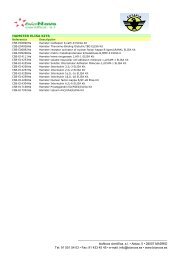Human NGAL Rapid ELISA Kit (KIT 037)
Human NGAL Rapid ELISA Kit (KIT 037)
Human NGAL Rapid ELISA Kit (KIT 037)
Create successful ePaper yourself
Turn your PDF publications into a flip-book with our unique Google optimized e-Paper software.
Early diagnosis of<br />
acute kidney injury in<br />
Critical illness<br />
Nephrotoxicity<br />
Kidney transplantation<br />
<strong>NGAL</strong> <strong>Rapid</strong> <strong>ELISA</strong> <strong>Kit</strong><br />
<strong>Human</strong><br />
<strong>NGAL</strong> <strong>Rapid</strong> <strong>ELISA</strong> <strong>Kit</strong><br />
(<strong>KIT</strong> <strong>037</strong>)<br />
Diagnostics<br />
For human urine, plasma or serum<br />
IVD<br />
*
www.bioporto.com<br />
2<br />
<strong>NGAL</strong> <strong>Rapid</strong> <strong>ELISA</strong> <strong>Kit</strong><br />
<strong>NGAL</strong><br />
<strong>NGAL</strong> – an early marker of kidney injury<br />
<strong>NGAL</strong> (neutrophil gelatinase-associated lipocalin, lipocalin-2) is a small protein expressed in neutrophils and<br />
certain epithelia, including the renal tubules. Renal expression of <strong>NGAL</strong> is dramatically increased after kidney<br />
injury, and <strong>NGAL</strong> is released into both urine and plasma. <strong>NGAL</strong> levels rise within 2 hours of the insult, making<br />
<strong>NGAL</strong> an early and sensitive biomarker of kidney injury.<br />
Clinical signifi cance<br />
<strong>NGAL</strong> levels may also be moderately raised in infections<br />
and certain cancers. Rises in <strong>NGAL</strong> above<br />
the baseline level for the patient may indicate acute<br />
kidney injury which may lead to acute renal failure.<br />
<strong>NGAL</strong> determination is relevant in, amongst others:<br />
1, 2<br />
Critically ill patients<br />
3, 4<br />
Kidney transplants<br />
Use of i.v. X-ray contrast agents<br />
30% or more of patients in intensive care may suffer<br />
some degree of acute renal failure. The onset of acute<br />
renal failure on top of other critical illness increases<br />
the mortality dramatically. The prognosis of acute<br />
renal failure has not improved signifi cantly over the<br />
last four decades. Current diagnostic methods such<br />
as serum creatinine or cystatin C measurements<br />
only respond after renal function has deteriorated,<br />
which may or may not become apparent until one<br />
or more days after the original insult. With the <strong>NGAL</strong><br />
<strong>Rapid</strong> <strong>ELISA</strong> <strong>Kit</strong>, physicians can initiate appropriate<br />
management of acute kidney injury within hours<br />
rather than days after the insult.<br />
5, 6<br />
Illustrative time-course of urinary <strong>NGAL</strong><br />
concentration after a moderate renal insult<br />
Illustrative time-course of the<br />
urinary <strong>NGAL</strong> level after a moderate<br />
renal insult.<br />
The red line represents a patient<br />
that with 90% positive predictive<br />
value will develop acute<br />
renal failure, while the green line<br />
represents a patient that will not<br />
develop acute renal failure.<br />
Urinary <strong>NGAL</strong><br />
Studies by BioPorto Diagnostics 1 have shown that<br />
the mean <strong>NGAL</strong> concentration in urine from healthy<br />
donors was 5.3 ng/mL (range 0.7-9.6 ng/mL). The<br />
mean <strong>NGAL</strong> concentration in plasma from healthy<br />
donors was 63 ng/mL (range 37-106 ng/mL). <strong>NGAL</strong><br />
levels rise steeply immediately after kidney injury. In<br />
unselected patients admitted to intensive care, the<br />
<strong>NGAL</strong> concentrations in urine ranged from 110 ng/mL<br />
to 40,000 ng/mL, while the mean <strong>NGAL</strong> concentration<br />
in EDTA plasma ranged from 25 ng/mL to 3500<br />
ng/mL. Urinary levels above a cut-off of 350 ng/mL or<br />
plasma levels above 400 ng/mL are associated with<br />
acute renal failure, with a positive predictive value of<br />
approximately 90%.<br />
Diagnostic cut-off<br />
Hours
<strong>NGAL</strong> <strong>Rapid</strong> <strong>ELISA</strong> <strong>Kit</strong> †<br />
Key features<br />
With the <strong>NGAL</strong> <strong>Rapid</strong> <strong>ELISA</strong> <strong>Kit</strong>, urine, plasma or<br />
serum samples can be analyzed in less than 1 hour<br />
in a standard laboratory with conventional <strong>ELISA</strong><br />
equipment. All components are stored at 4°C and<br />
incubations performed at room temperature.<br />
The kit contains ready-to-use calibrators, reagents<br />
and pre-coated well strips, which greatly reduces the<br />
hands-on time. The simple test protocol combines<br />
high reproducibility with rapid analysis.<br />
1-hour rapid assay format<br />
For in-vitro diagnostic (IVD) use in<br />
selected countries*<br />
Measures in urine, plasma and serum<br />
All reagents are ready to use<br />
Automation possible on open <strong>ELISA</strong> workstations<br />
Assay dynamic range is 100-fold<br />
<strong>Kit</strong> components<br />
Item Contents Quantity<br />
1<br />
12 x 8 coated Microwells +<br />
Frame<br />
Ordering information<br />
96 wells<br />
2 5x Sample Diluent Concentrate 1 x 60 mL<br />
3a - 3f<br />
<strong>NGAL</strong> <strong>Rapid</strong> Calibrator 1-6<br />
The exact concentration of each calibrator<br />
is printed on the label of the vials and on<br />
the QC-certifi cate.<br />
6 x 1 mL<br />
4 25x Wash Solution Concentrate 1 x 30 mL<br />
5 HRP-conjugated <strong>NGAL</strong> Antibody 1 x 6 mL<br />
6 TMB Substrate 1 x 12 mL<br />
7 Stop Solution 1 x 16 mL<br />
8 Polypropylene U-Microwell Plate 96 wells<br />
Assay procedure<br />
H<br />
H<br />
S<br />
S S<br />
H H<br />
Assay procedure<br />
Cat. No. Product name Size<br />
<strong>KIT</strong> <strong>037</strong> <strong>NGAL</strong> <strong>Rapid</strong> <strong>ELISA</strong> <strong>Kit</strong> 96 wells<br />
WASH <strong>037</strong>-30 25x Wash Solution Concentrate for <strong>KIT</strong> <strong>037</strong> 30 mL<br />
WASH <strong>037</strong>-250 25x Wash Solution Concentrate for <strong>KIT</strong> <strong>037</strong> 250 mL<br />
† Patent application WO2006066587, issued in South Africa, New Zealand and Singapore.<br />
* Please visit www.bioporto.com for availability in your country.<br />
IVD<br />
H H<br />
*<br />
<strong>NGAL</strong> antibody<br />
Plates are precoated with<br />
the primary <strong>NGAL</strong> antibody.<br />
Plates are ready to use.<br />
H<br />
HRP-conjugated<br />
<strong>NGAL</strong> antibody<br />
HRP-conjugated detection antibody<br />
is added to each well.<br />
<strong>NGAL</strong><br />
Calibrators and diluted samples<br />
are added to the wells.<br />
Incubate for 30 minutes.<br />
S TMB Substrate<br />
Substrate is added to each<br />
well.<br />
Stop Solution<br />
Stop Solution is added to each<br />
well after 15 minutes. Quantitative<br />
results are obtained by<br />
measuring the absorbance at<br />
450 nm.<br />
<strong>NGAL</strong> <strong>Rapid</strong> <strong>ELISA</strong> <strong>Kit</strong><br />
30 min.<br />
15 min.<br />
Total assay time<br />
less than 1 hour<br />
www.bioporto.com<br />
3
<strong>NGAL</strong> <strong>Rapid</strong> <strong>ELISA</strong> <strong>Kit</strong><br />
Related products<br />
Cat. No. Product name<br />
<strong>KIT</strong> 036 <strong>NGAL</strong> <strong>ELISA</strong> <strong>Kit</strong><br />
HYB 211* Mouse monoclonal anti-human <strong>NGAL</strong> antibodies<br />
*Also available biotinylated.<br />
Animal <strong>NGAL</strong> products<br />
BioPorto Diagnostics also offers <strong>ELISA</strong> kits and monoclonal antibodies specific for rat, mouse, guinea pig,<br />
cat, dog, pig or monkey (Cynomolgus) <strong>NGAL</strong>. For more information please visit www.ngal.com.<br />
References<br />
1. Bangert K, Heslet L, Ghiglione M, Uttenthal LO (2006) <strong>NGAL</strong> is significantly increased in urine and plasma in acute renal failure.<br />
Intensive Care Med 32 (Supplement 1):S10.<br />
2. Makris K, Markou N, Evodia E, Dimopoulou E, Drakopoulos I, Ntetsika K, Rizos D, Baltopoulos G, Haliassos A (2009) Urinary<br />
neutrophil gelatinase-associated lipocalin (<strong>NGAL</strong>) as an early marker of acute kidney injury in critically ill multiple trauma patients.<br />
Clin Chem Lab Med 47:79-82.<br />
3. Kusaka M, Kuroyanagi Y, Mori T, Nagaoka K, Sasaki H, Maruyama T, Hayakawa K, Shiroki R, Kurahashi H, Hoshinaga K (2008)<br />
Serum neutrophil gelatinase-associated lipocalin as a predictor of organ recovery from delayed graft function after kidney<br />
transplantation from donors after cardiac death. Cell Transplant 17:129-134.<br />
4. Malyszko J, Malyszko JS, Bachorzewska-Gajewska H, Poniatowski B, Dobrzycki S, Mysliwiec M (2009) Neutrophil gelatinaseassociated<br />
lipocalin is a new and sensitive marker of kidney function in chronic kidney disease patients and renal allograft<br />
recipients. Transplant Proc 41:158-161.<br />
5. Bachorzewska-Gajewska H, Malyszko J, Sitniewska E, Malyszko JS, Dobrzycki S (2006) Neutrophil-gelatinase-associated<br />
lipocalin and renal function after percutaneous coronary interventions. Am J Nephrol 26:287-292.<br />
6. Di Grande A, Giuffrida C, Carpinteri G, Narbone G, Pirrone G, Di Mauro A, Calandra S, Noto P, Le Moli C, Alongi B, Nigro F (2009)<br />
Neutrophil gelatinase-associated lipocalin: a novel biomarker for the early diagnosis of acute kidney injury in the emergency<br />
department. Eur Rev Med Pharmacol Sci 13:197-200.<br />
Other useful references<br />
7. Bolignano D, Lacquaniti A, Coppolino G, Donato V, Campo S, Fazio MR, Nicocia G, Buemi M (2009) Neutrophil gelatinaseassociated<br />
lipocalin (<strong>NGAL</strong>) and progression of chronic kidney disease. Clin J Am Soc Nephrol 4:337-344.<br />
8. Damman K, van Veldhuisen DJ, Navis G, Voors AA, Hillege HL (2008) Urinary neutrophil gelatinase associated lipocalin (<strong>NGAL</strong>),<br />
a marker of tubular damage, is increased in patients with chronic heart failure. Eur J Heart Fail 10:997-1000.<br />
9. Poniatowski B, Malyszko J, Bachorzewska-Gajewska H, Malyszko JS, Dobrzycki S (2009) Serum neutrophil gelatinase-associated<br />
lipocalin as a marker of renal function in patients with chronic heart failure and coronary artery disease. Kidney Blood Press Res<br />
32:77-80.<br />
10. Yang YH, He XJ, Chen SR, Wang L, Li EM, Xu LY (2009) Changes of serum and urine neutrophil gelatinase-associated lipocalin in<br />
type-2 diabetic patients with nephropathy: one year observational follow-up study. Endocrine 36:45-51.<br />
For more information, please contact BioPorto Diagnostics or your local BioPorto Diagnostics distributor<br />
BioPorto Diagnostics A/S<br />
Grusbakken 8<br />
DK-2820 Gentofte<br />
Denmark<br />
Diagnostics<br />
Phone (+45) 4529 0000<br />
Fax (+45) 4529 0001<br />
E-mail info@bioporto.com<br />
Web www.bioporto.com<br />
www.ngal.com<br />
Distributed by:<br />
50201/092009/e · Revision: 2009-09



